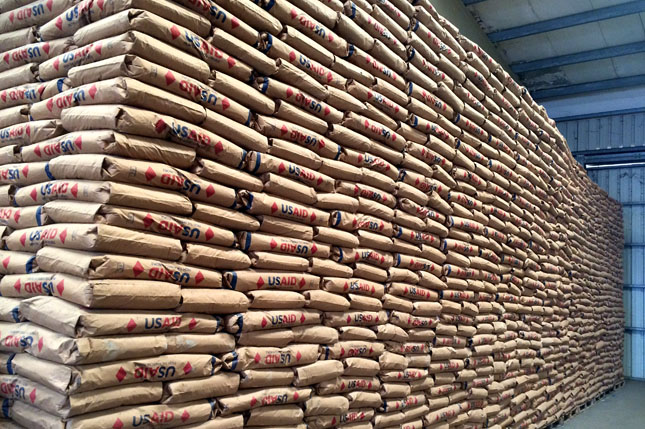-
Inside a Data-Driven Attempt to Fight Spoilage in U.S. Food Aid
July 19, 2016 By Mark Brennan
Today, as El Niño-related droughts impact communities across East and Southern Africa, food aid shipment and distribution networks have shifted into high gear. From the U.S. Agency for International Development to the United Nations World Food Program and NGOs like CARE and Save the Children, food aid providers are stocking port warehouses in Djibouti and South Africa, as well as inland warehouses in countries like Ethiopia, Zimbabwe, and Lesotho.
Every year millions of metric tons of food aid – enough food to fill the hulls of dozens of ships and tens of thousands of containers – move across the ocean, through warehouses, and eventually into beneficiaries’ homes. And every year, spoilage plagues this supply chain, as it does any perishable product. USAID conservatively estimates one percent of all food aid shipped every year spoils. And while one percent may not seem earth-shattering, American food aid programs typically reach more than 45 million people with more than 1 million metric tons of food each year – a total value of about $1.5 billion. One percent of $1.5 billion amounts to $15 million.
Packaging that maintains food quality through harsh conditions – hot temperatures, swarming insects, high humidity – therefore has the potential to save money and ensure more aid ends up in the hands that need it most. Last September, the Massachusetts Institute of Technology’s Comprehensive Initiative on Technology Evaluation, or CITE, began a project with USAID’s Office of Food for Peace to review new packaging options for food aid, design a trial procurement, and test them. These new packaging options are now rolling out through a trial procurement and we will shortly begin to evaluate results.
Studying the Options
Almost all food aid is distributed in 25-kilogram paper bags or 50-kilogram polypropylene bags. For this pilot we are considering standard bags with airtight liners and airtight liners for entire shipping containers. Airtight liners create a barrier between the food – typically bulk cereals – and the insects and humidity in the environment, as well as limit the available oxygen that insects already inside food aid use to live and reproduce.
We are also considering a class of chemical called an insect growth regulator, which can be applied to standard bags and prevent insects that chew through bags from maturing from one life stage to the next. An insect growth regulator is sometimes applied to perishable packaged goods in the United States.
American food aid programs typically reach more than 45 million people each yearPer bag, the addition of an airtight liner is more expensive than the application of an insect growth regulator. Both options may be able to control insect infestation, but airtight liners – if they can remain intact throughout the supply chain – may offer food aid protection against high humidity as well.
In addition to modifications to the standard 25- and 50-kilogram bags currently used in ocean shipping and distribution, we are also exploring the use of 1,000-kilogram bags for ocean shipping. These bags may offer some shipping and handling efficiencies in the United States, where some suppliers use them with commercial customers. However, as most operations in ports that receive food aid are not mechanized, any initial efficiencies may be overshadowed by the inefficiencies of handling 1,000-kilogram bags on the receiving end and re-bagging their contents into 25-kilogram and 50-kilogram bags for distribution to beneficiaries.
The new packaging options that involve airtight liners or insect growth regulators are being tested to understand if they do not require fumigation. Fumigation gases are regularly applied to shipments of food aid to kill insects, rodent, and bird infestations. With standard bags, fumigation is applied to shipments prophylactically, based on the assumption that there may be a minor pest population that has the potential to infest a commodity, or at the sign of an infestation, which usually entails a stack of bags literally crawling with insects.
Avoiding fumigation can potentially save time and money. When an entire warehouse is fumigated it has to be sealed off for many days, and the cost of fumigating can vary from about $0.5 per metric ton of food aid to $3 per metric ton of food aid. Additionally, if we can eliminate the need for fumigation, we may also eliminate the danger of improperly applied fumigation.
We are evaluating nine new packaging types through a procurement of around 1,000 metric tons of three representative types of food aid – a milled product, a grain, and a pulse – which will be shipped to Djibouti and Durban from the United States.
The three food aid types were awarded via the usual competitive bidding process this spring to four firms by the U.S. Department of Agriculture. USAID issued a similar solicitation to supply ocean shipping, and awarded the bid to three large ocean liners.
In late August, the food aid will make its way from mills and suppliers in the United States to ports where it will be loaded onto ships.
By the end of this fall, half the food aid will have arrived in Djibouti and the other half in Durban. It will remain in warehouses for about three months where the effectiveness of the bags with liners and insect growth regulator will be monitored for quality in the absence of any fumigation. Djibouti and Durban have different temperatures, insects, and humidity, allowing us to evaluate the effectiveness of the new bags in several environmental dimensions.
More, Better, Faster
Part of our research group of three is currently in East Africa working with receiving warehouses, monitoring and evaluation partners, and implementing partners in anticipating of the food aid’s arrival. The team will evaluate each packaging option for its cost effectiveness and technical effectiveness. To understand the total cost of each packaging option, we will look at the cost of bids submitted and awarded, and conduct fieldwork across the United States and Africa to estimate material and handling costs. Similarly, we will collect data from our monitoring and evaluation partners at domestic shipping sites and at the ports of Djibouti and Durban.
At the conclusion of the study, we hope to better understand the cost-effectiveness of a wide range of packaging options to enable USAID and similar organizations to make data-driven decisions about which will work best in a variety of contexts.
Working in Djibouti this week, where warehouses are stocked high, ships are lining up to unload sorghum and wheat, and trucks leave by the dozen for Ethiopia, shows the mundane but critical role packaging plays in food aid. Better packaging could mean less time and money spent on fumigation, less food lost to spoilage, and increased operational flexibility. This study has the potential to change how much, to where, and when the United States sends food aid, bringing aid faster, to more people, in more places.
For updates on this project, follow @CITEatMIT and #followthefoodaid.
Mark Brennan is a researcher at the Massachusetts Institute for Technology Center for Transportation and Logistics and the Comprehensive Initiative on Technology Evaluation, which is supported by USAID’s Global Development Lab. He is traveling in Djibouti and Durban in part supported by an MIT Public Service Fellowship.
Sources: Comprehensive Initiative on Technology Evaluation, U.S. Agency for International Development, U.S. Department of Agriculture.
Photo Credit: U.S. food aid in storage, used with permission courtesy of Mark Brennan.
 A Publication of the Stimson Center.
A Publication of the Stimson Center.






